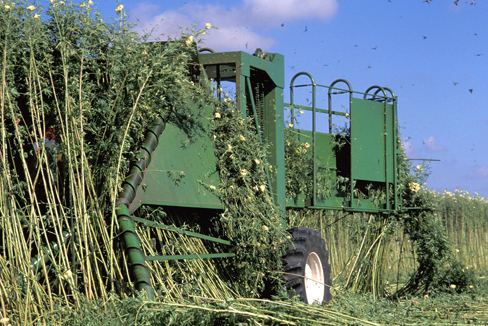Kenaf
Kenaf (Hibiscus cannabinus) is a warm-season annual row crop in the same plant family as okra and cotton (Malvaceae). Kenaf plants are capable of growing to a height of 20 feet under favorable conditions; however, heights generally average 8 to 14 feet in a growing season of 4 to 5 months. The stalks consist of two kinds of fiber: an outer fiber (bast) and an inner fiber (core). The bast is comparable to softwood tree fibers, while the core is comparable to hardwood fibers. After harvest, the plant is processed to separate these fibers for various products.
Marketing
Most of the world’s kenaf is produced in India and China. The domestic demand for kenaf is currently limited. Early predictions that kenaf would replace trees for papermaking have not come to pass. Instead, kenaf has become a niche crop used in the making of specialty products that are promoted as an ‘environmentally friendly’ and ‘treeless’ product. Because the harvested stalks are too bulky to ship any distance, kenaf production necessarily must be located near a processing plant. At this time, the only known commercial processing plants in the U.S. are located in Georgia, Mississippi, North Carolina, and Texas. All acreage is contract-grown for these companies. Despite this crop’s apparent promise as a ready source of fiber, the lack of any nearby processing plant makes kenaf an uncertain alternative crop for Kentucky.
Production
 Kenaf is well adapted to a wide range of soil types; however, best yields occur on well-drained fertile sites. While abundant soil moisture is necessary, waterlogged or poorly drained soils are a detriment to growth. Kenaf’s sensitivity to frost is an important consideration when selecting a suitable site. Seeds are broadcast or drilled after all danger of frost has passed. It is important to plant into a fine, well-prepared seedbed to provide good seed-to-soil contact for germination. This crop is grown in dense stands to limit branching and promote the development of long fibers in the main stem.
Kenaf is well adapted to a wide range of soil types; however, best yields occur on well-drained fertile sites. While abundant soil moisture is necessary, waterlogged or poorly drained soils are a detriment to growth. Kenaf’s sensitivity to frost is an important consideration when selecting a suitable site. Seeds are broadcast or drilled after all danger of frost has passed. It is important to plant into a fine, well-prepared seedbed to provide good seed-to-soil contact for germination. This crop is grown in dense stands to limit branching and promote the development of long fibers in the main stem.

